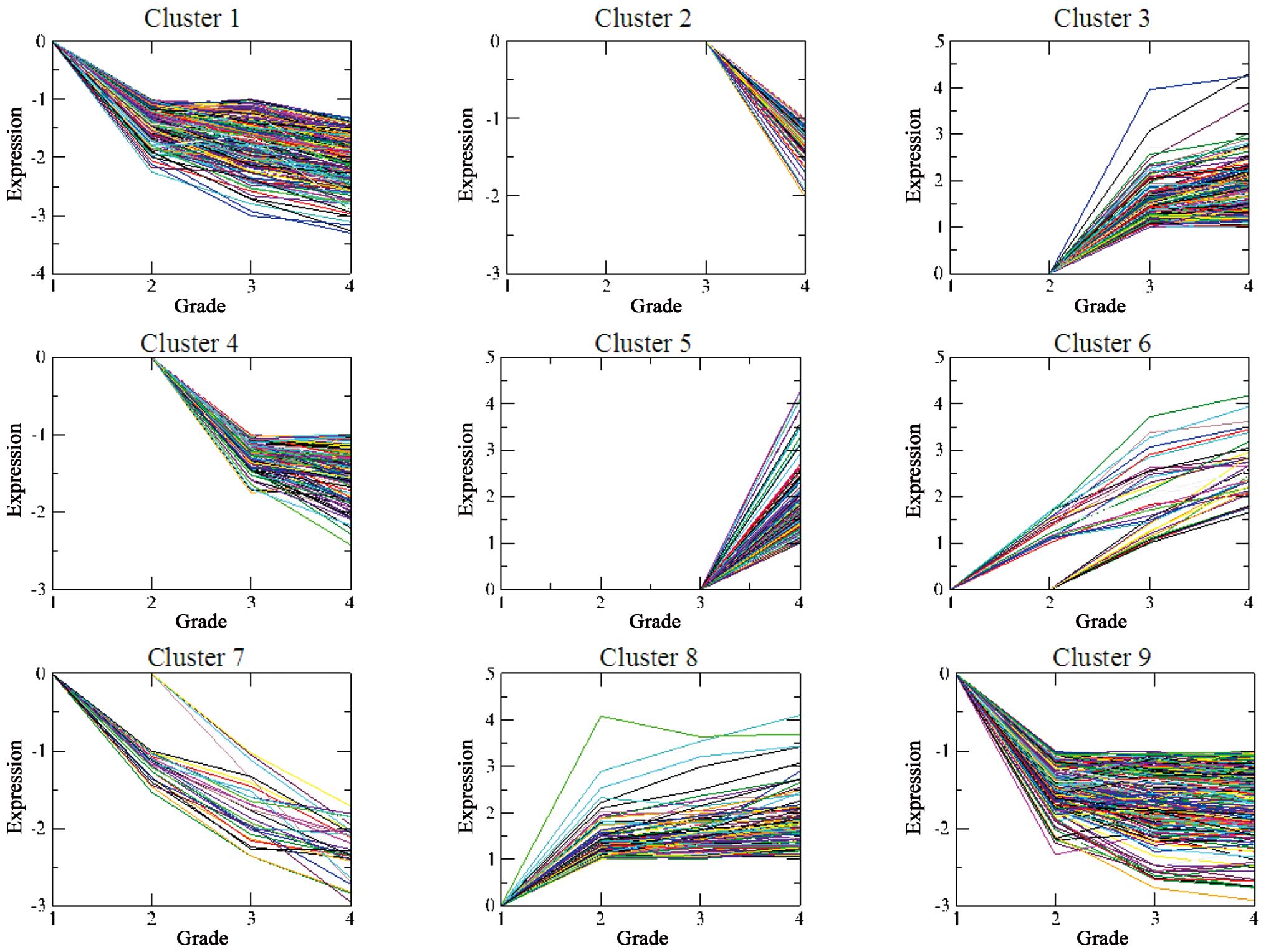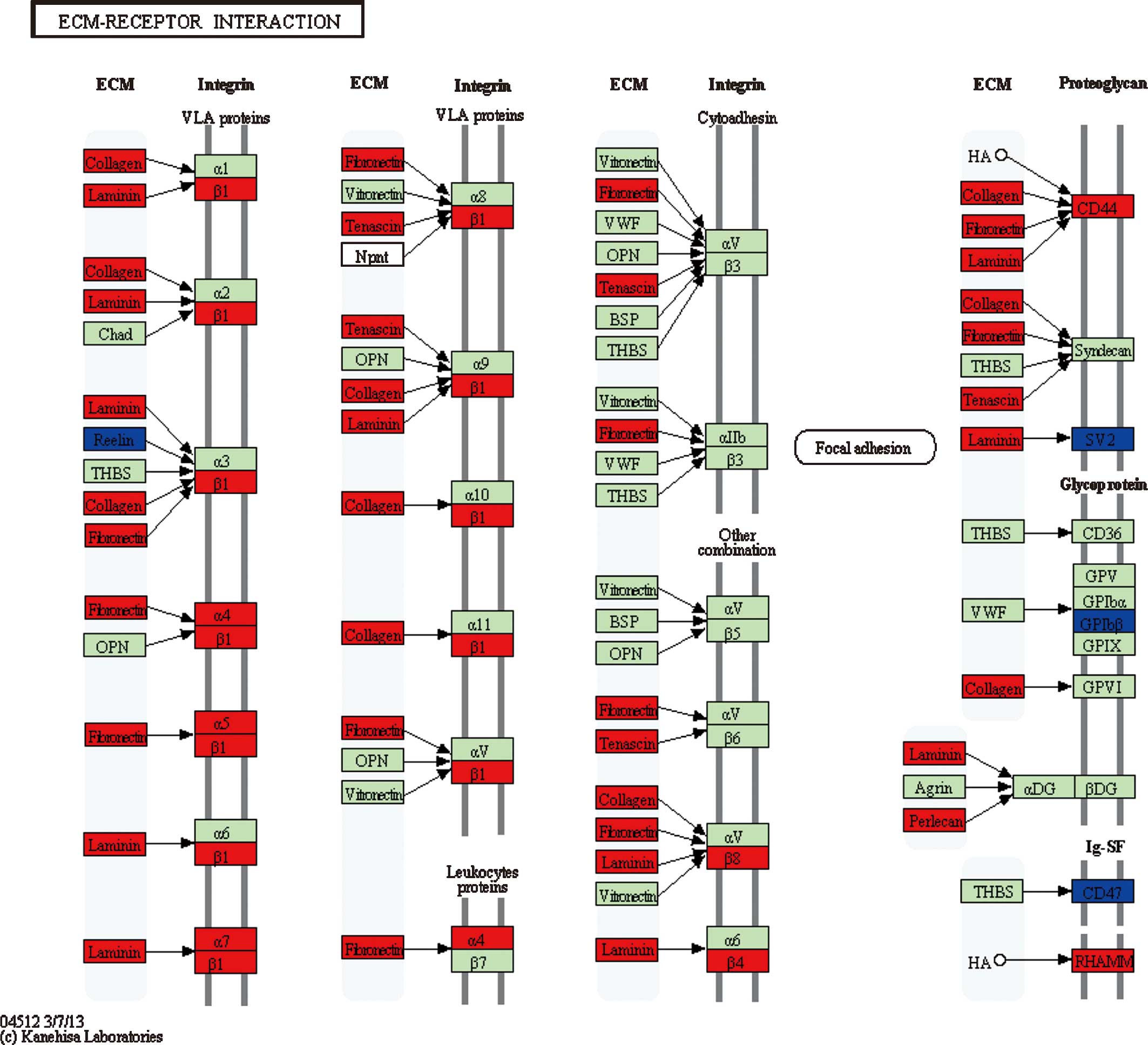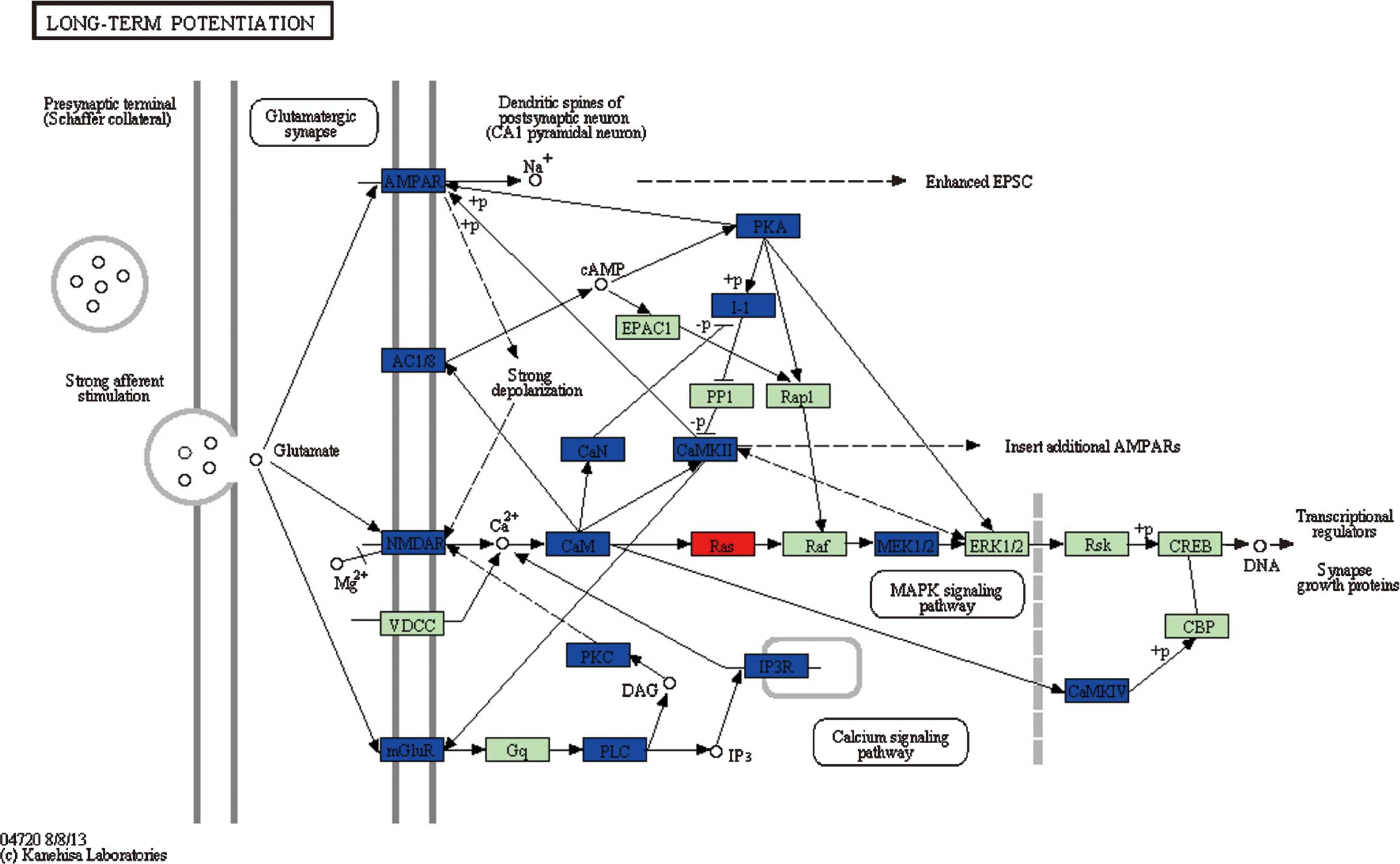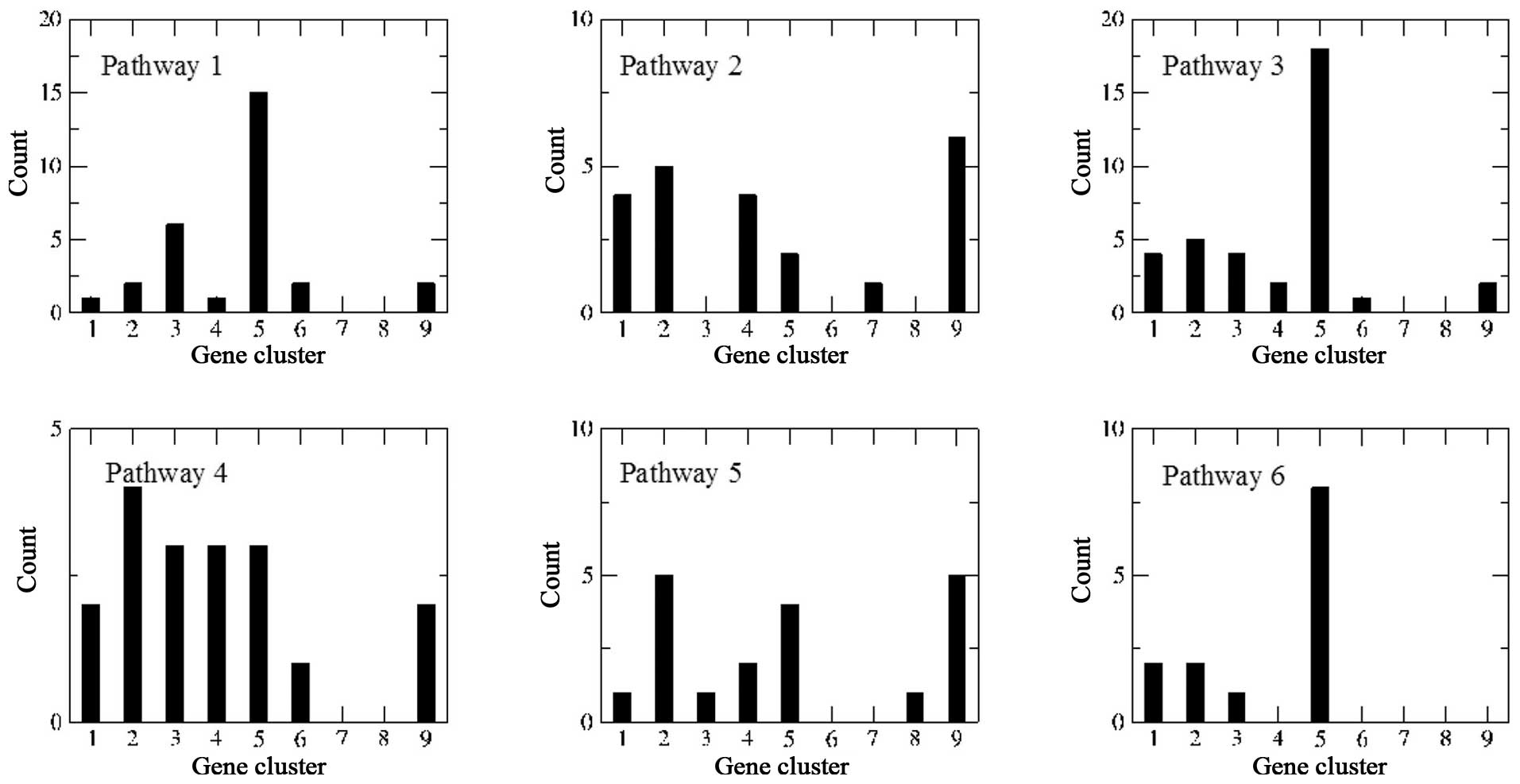Analysis of gene expression profiles associated with glioma progression
- Authors:
- Published online on: April 1, 2015 https://doi.org/10.3892/mmr.2015.3583
- Pages: 1884-1890
-
Copyright: © Hu et al. This is an open access article distributed under the terms of Creative Commons Attribution License [CC BY_NC 3.0].
Abstract
Introduction
Glioma is the most common and most aggressive malignant primary brain tumor in humans, with a morbidity rate of 6/100,000 and a five-year survival rate of 20–30% (1). Gliomas are classified into low-grade types (I or II) with slow or relatively slow growth, and high-grade types (III or IV), with fast growth and spread into normal brain tissue based on the World Health Organization (WHO) grading system (2). Patients with glioblastoma, the highest-grade glioma, survive for no more than one year following diagnosis, as there are still no efficient treatment protocols at present (3). Therefore, early diagnosis of gliomas is crucial for improving the survival of patients.
At present, diagnosis of gliomas is mainly based on histological detection, which, however, cannot reflect the pathological changes at the cellular and molecular levels timely and efficiently. Although the importance of numerous genes, including TP53, PTEN, EGFR, MDM2, CDKN2A and CDKN2B (4–6), during glioma progression has been proven, assays for individual genes/proteins or in combination with histological features are neither predictive of survival of glioma patients nor able to guide therapeutic decisions (7). By constrast, microarrays can provide tremendous information at the transcription level, and are thus likely to reveal dynamic changes in the expression of multiple genes simultaneously. To date, microarray analysis has been successfully used to identify unknown tumor glioma subtypes (8), and gene-based classification has been proven to better correlate with patient survival than histological classification (9).
In the present study, microarray analysis data were subjected to bioinformatics analysis in order to investigate changes at the transcript level that are associated with spontaneous glioma progression, with the objective to discover novel targets for glioma diagnosis and therapy. First, gene expression profile data of glioma samples were compared with non-cancerous samples from epilepsy patients to detect the differentially expressed genes (DEGs) by the significance analysis of microarray (SAM) method. Then, the short time-series expression miner (STEM) method was applied to class these DEGs based on their degree of differentiation in the process of tumor progression. Finally, EnrichNet was used to analyze the enrichment of classified DEGs on Kyoto Encyclopedia of Genes and Genomes (KEGG) pathways based on a protein-protein interaction (PPI) network.
Materials and methods
Affymetrix microarray data
The expression profile of GSE4290 (10) was acquired from the Gene Expression Omnibus (GEO, http://www.ncbi.nlm.nih.gov/geo/) database. The platform of those data is GPL570 [HG-U133_Plus_2] Affymetrix Human Genome U133 Plus 2.0 Array. In total, 23 brain tissue samples from epilepsy patients as non-tumor (control) samples and 157 glioma samples, including 26 astrocytoma samples (7 grade II and 19 grade III), 50 oligodendroglioma samples (38 grade II and 12 grade III) and 81 glioblastoma samples (grade IV) were used.
Data pre-processing
First, the expression microarray data-sets of the glioma and control samples were extracted using the R affy package (http://www.bioconductor.org/packages/release/bioc/html/affy.html). Then, the Robust Multiarray Average (RMA) method, practically supported by the justRMA function of the R affy package, was used to normalize the data through log 2 transformation (11).
DEG screening and clustering
Significance analysis of micro-array (SAM) of two classes of unpaired measurements was performed for DEG identification using the MeV software (12). Only genes with |log fold change (FC)|≥2 and a false detection rate (FDR) <0.05 were regarded as DEGs between the control and the tumor samples. Regardless of the cell type, DEGs at three grades (II, III and IV) were obtained. Using the Short Time Series Expression Miner (STEM) method specifically designed for the analysis of short time series gene expression data by Ernst and Bar-Joseph (13), these DEGs were classified according to their differential expression degrees during tumor progression.
Construction of PPI network and KEGG pathway enrichment analysis
The web-accessible online bioinformatics tool EnrichNet (http://www.enrichnet.org/) was used to perform a functional enrichment analysis of the classified DEGs (14) through calculating the overlaps between KEGG pathway and PPI network built with the self-defined gene sets. Unlike the methods (e.g. WebGestalt, http://bioinfo.vanderbilt.edu/webgestalt/ and DAVID, http://david.abcc.ncifcrf.gov/) that only consider overlaps between self-defined gene sets and a known KEGG pathway gene and address the importance of overlaps based on the q-value by statistical tests (eg. one-sided Fisher’s exact test), EnrichNet is an analytical method based on protein-protein interaction (PPI) networks. First, a PPI network was built using the Search Tool for the Retrieval of Interacting Genes (STRING) database (15). Then, by comparing the PPI network with the KEGG database, the similarity degree between PPI and a certain pathway was determined using EnrichNet, which is expressed as the XD-score, with a higher XD-score meaning a greater similarity, indicating higher probability of enrichment in a certain KEGG pathway. To help set the XD-score threshold, EnrichNet also calculated the significance score (q-value) by the classical overlap-based Fisher test, followed by linear regression analysis with XD-score, by which the XD-score corresponding to the q-value of 0.05 was selected as the threshold. Eventually, the obtained Pearson correlation coefficient was 0.85, and the XD-score was set at 0.96.
Results
Screening of DEGs
Through microarray analysis, a total of 4,506 DEGs were detected and the number of DEGs increased with the increasing glioma grade, with the largest number of DEGs (2,580) in grade IV cells. The top ten up- and downregulated DEGs at each grade were listed by their FC value (Table I).
Table ITop ten down- and upregulated differentially expressed genes in grade II, grade III and grade IV glioma samples. |
Grade-dependent gene clustering
Several genes were not differentially expressed at all the three grades, and the missing expression value was assigned as 0. According to STEM analysis, the DEGs were grouped into nine important gene clusters, which were ranked according to their significance (P-value) (Table II). The differences in the expression values of almost all the DEGs increased with the increasing grade: DEGs in clusters 1, 6, 7, 8 and 9 revealed differential expressions at grade II, while DEGs in clusters 3 and 4 revealed differential expression at grade III, and DEGs in clusters 2 and 5 exhibited differential expression at grade IV (Fig. 1).
Pathway enrichment analysis of the PPI network
A total of 2,199 genes in the nine clusters were submitted to EnrichNet to construct a PPI network, followed by KEGG pathway enrichment analysis. Finally, 11 KEGG pathways with XD-scores larger than the threshold (0.96) were re-ranked according to their corresponding Fisher q-values (Table III). If q-value <0.05 was set as the threshold, only the first six pathways were enriched.
Table IIIEnriched Kyoto Encyclopedia of Genes and Genomes pathways for differentially expressed genes in the protein-protein interaction network. |
For pathway 1 [extracellular matrix (ECM)-receptor interaction] (Fig. 3), 3 (phagosome) and 6 (type I diabetes mellitus), genes participating in these three pathways largely belonged to cluster 5. For example, the collagen-encoding genes (COL1A2, COL3A1, COL4A1 and COL6A2) and integrin-encoding genes (ITGA and ITGB) in pathways 1 and 3, and HLA genes (HLA-DPA1, HLA-DPB1, HLA-DQB1, HLA-DRA, HLA-DRB1 and HLA-G) in pathways 3 and 6 may have important roles in the development progress of malignant gliomas. For pathways 2 (long-term potentiation) (Fig. 4), 4 (Vibrio cholerae infection) and 5 (epithelial cell signaling in Helicobacter pylori infection), genes involved in these three pathways belonged to different clusters, indicating that these genes may be associated with the occurrence of glioma. In particular, genes belonging to clusters 1, 8 and 9, which were differentially expressed in grade II glioma cells, accounted for nearly 50% of DEGs in pathway 2 (Fig. 2).
Discussion
In the present study, the DEGs enriched in pathways 1, 3 and 6 mainly belonged to cluster 5 and were differentially expressed at grade IV, indicating that these pathways and their associated DEGs may have important roles in the deterioration of glioma into glioblastoma. Among these DEGs, integrin-encoding genes (ITGA and ITGB) were observed to be upregulated in pathways 1 and 3. Taking the ECM-receptor interaction pathway as an example, it refers to the interaction between ECM components and glioma cells, during which cellular matrix receptors function as mediators, and this interaction was previously reported to be responsible for the clinically important features of malignant gliomas, including cerebral invasion and leptomeningeal spread (16). Integrins, a major group of ECM receptors, which are involved in the adhesion and basement membrane invasion of glioma cells (16), were upregulated in this pathway. Collagen-encoding genes, which were markedly upregulated, took a large proportion of DEGs in the first pathway and mostly belonged to cluster 5, suggesting their important role in the deterioration of glioma into glioblastoma. Collagens are primary components in the ECM of most cell types and have been reported to be elevated in gliomas compared to those in normal adult brain cells as well as to have an important role in driving tumor progression (17). In this pathway, a small number of genes, including SV2 (SV2B and SV2C), were differentially expressed very early at grade II. Synaptic vesicle glycoproteins (SV2; with the three different isoforms SV2A, SV2B and SV2C) are a group of integral transmembrane proteins (18) with an important role in the development of the central nervous system (19,20). According to a study on patients orally administrated with levetiracetam following surgery, an obvious increase in SV2 expression was observed in those with a good response (21), suggesting that higher SV2 levels may indicate a good prognosis. Thus, the significant decrease in SV2 expression at grade II in this pathway was speculated to correlate with the occurrence of glioma. In addition, human leukocyte antigen (HLA) genes, including HLA-DPA1, HLA-DPB1, HLA-DQB1, HLA-DRA, HLA-DRB1 and HLA-G, took a large proportion of DEGs in either pathway 3 or 6, particularly in pathway 6, in which these genes were upregulated at grade IV, conforming to the significant expression of HLA-DQB1 and HLA-DRB1 in patients with high-grade glioma (HGG) observed by La Torre et al (22), and the positive correlation between HLA-DRB1 and symptomatic cerebral glioma reported by Guerini et al (23). Furthermore, introduction of HLA-G1 or HLA-G5 into HLA-G-negative glioma cells (U87MG) rendered them highly resistant to direct alloreactive lysis, inhibited the alloproliferative response and prevented efficient priming of cytotoxic T cells (24); thus, this gene may contribute to the immune escape in human glioblastoma.
Furthermore, DEGs exclusively detected at grade IV with large FC values (i.e., IGFBP2 and GABRA5) revealed huge variation in expression levels compared to previous grades, which was speculated to be closely correlated with the significant changes during the development of glioma into glioblastoma. IGFBP2 was reported to be overexpressed in glioblastoma and promote glioma tumor stem cell expansion and survival (25). Gamma-aminobutyric acid (GABA) A receptor, alpha 5 (GABRA5) (26) is a part of the extrasynaptic GABA A-channels and involved in tonic currents (27). The lowest GABRA5 mRNA levels were found in glioblastoma compared to gliomas of lower malignancy (28), which is consistent with the remarkable decrease in GABRA5 expression.
Since the DEGs participating in pathways 2, 4 and 5 belong to different clusters, it can be inferred that these pathways and their associated DEGs may have a role at each stage during glioma progression. As the long-term potentiation pathway contained a large proportion of DEGs from clusters 1, 8 and 9, which were differentially expressed in very low-grade glioma cells, it is presumed that this pathway is closely associated with the occurrence of glioma. This pathway has been widely considered as one of the major cellular mechanisms that underlies learning and memory (29). Memory reduction is the most important and distinctive feature in high-grade glioma, thus it can be inferred that memory impairment in high-grade glioma patients is associated with the pathological changes in this molecular process, which may be attributed to the alterations in gene expression in this pathway. Compared to changes observed by Dong et al (30) in the LTP enrichment pathway, there were no significant changes observed in the expression of PP1, Rap1, Raf and ERK1/2, with downregulation of I-1, AMPAR and AC1/8 expression, and upregulation of Ras in the present study. The difference in the expression of these genes may be attributed to the difference in sample size, and should be further investigated. Additionally, Dong et al (30) observed the downregulation of mGluR5 expression in this pathway at grade II, which is consistent with a previous study that reported the impaired learning and reduced CA1 LTP in mice lacking mGluR5 (31).
In conclusion, long-term potentiation and ECM-receptor interaction were discovered to have an important role in the occurrence and development of gliomas, which may provide a novel and comprehensive view for the treatment of gliomas. The associated DEGs, including SV2, NMDAR and mGluRs, can be considered to be used as biomarkers or therapeutic targets for gliomas. However, the results of the present study require to be further confirmed by additional experiments.
References
|
Mamelak AN and Jacoby DB: Targeted delivery of antitumoral therapy to glioma and other malignancies with synthetic chlorotoxin (TM-601). Expert Opin Drug Deliv. 4:175–186. 2007. View Article : Google Scholar : PubMed/NCBI | |
|
Goebell E, Paustenbach S, Vaeterlein O, et al: Low-grade and anaplastic gliomas: differences in architecture evaluated with diffusion-tensor MR imaging. Radiology. 239:217–222. 2006. View Article : Google Scholar : PubMed/NCBI | |
|
Fine HA, Dear KB, Loeffler JS, Black PM and Canellos GP: Meta-analysis of radiation therapy with and without adjuvant chemotherapy for malignant gliomas in adults. Cancer. 71:2585–2597. 1993. View Article : Google Scholar : PubMed/NCBI | |
|
Stark AM, Hugo H, Witzel P, Mihajlovic Z and Mehdorn HM: Age-related expression of p53, Mdm2, EGFR and Msh2 in glioblastoma multiforme. Zentralbl Neurochir. 64:30–36. 2003. View Article : Google Scholar : PubMed/NCBI | |
|
Li J, Yen C, Liaw D, et al: PTEN, a putative protein tyrosine phosphatase gene mutated in human brain, breast and prostate cancer. Science. 275:1943–1947. 1997. View Article : Google Scholar : PubMed/NCBI | |
|
Simon M, Köster G, Menon AG and Schramm J: Functional evidence for a role of combined CDKN2A (p16-p14ARF)/CDKN2B (p15) gene inactivation in malignant gliomas. Acta Neuropathol. 98:444–452. 1999. View Article : Google Scholar : PubMed/NCBI | |
|
Freije WA, Castro-Vargas FE, Fang Z, et al: Gene expression profiling of gliomas strongly predicts survival. Cancer Res. 64:6503–6510. 2004. View Article : Google Scholar : PubMed/NCBI | |
|
Shai R, Shi T, Kremen TJ, et al: Gene expression profiling identifies molecular subtypes of gliomas. Oncogene. 22:4918–4923. 2003. View Article : Google Scholar : PubMed/NCBI | |
|
Nutt CL, Mani D, Betensky RA, et al: Gene expression-based classification of malignant gliomas correlates better with survival than histological classification. Cancer Res. 63:1602–1607. 2003.PubMed/NCBI | |
|
Sun L, Hui AM, Su Q, et al: Neuronal and glioma-derived stem cell factor induces angiogenesis within the brain. Cancer Cell. 9:287–300. 2006. View Article : Google Scholar : PubMed/NCBI | |
|
Gruber HE, Ingram JA, Hoelscher GL, Zinchenko N, Hanley EN Jr and Sun Y: Asporin, a susceptibility gene in osteoarthritis, is expressed at higher levels in the more degenerate human inter-vertebral disc. Arthritis Res Ther. 11:R472009. View Article : Google Scholar | |
|
Larsson O, Wahlestedt C and Timmons JA: Considerations when using the significance analysis of microarrays (SAM) algorithm. BMC Bioinformatics. 6:1292005. View Article : Google Scholar : PubMed/NCBI | |
|
Ernst J and Bar-Joseph Z: STEM: a tool for the analysis of short time series gene expression data. BMC Bioinformatics. 7:1912006. View Article : Google Scholar : PubMed/NCBI | |
|
Glaab E, Baudot A, Krasnogor N, Schneider R and Valencia A: EnrichNet: network-based gene set enrichment analysis. Bioinformatics. 28:i451–i457. 2012. View Article : Google Scholar : PubMed/NCBI | |
|
Szklarczyk D, Franceschini A, Kuhn M, et al: The STRING database in 2011: functional interaction networks of proteins, globally integrated and scored. Nucleic Acids Res. 39(Database Issue): 561–568. 2011. View Article : Google Scholar | |
|
Paulus W and Tonn JC: Interactions of glioma cells and extracellular matrix. J Neurooncol. 24:87–91. 1995. View Article : Google Scholar : PubMed/NCBI | |
|
Payne LS and Huang PH: The pathobiology of collagens in glioma. Mol Cancer Res. 11:1129–1140. 2013. View Article : Google Scholar : PubMed/NCBI | |
|
Bajjalieh SM, Peterson K, Shinghal R and Scheller RH: SV2, a brain synaptic vesicle protein homologous to bacterial transporters. Science. 257:1271–1273. 1992. View Article : Google Scholar : PubMed/NCBI | |
|
Dong M, Yeh F, Tepp WH, et al: SV2 is the protein receptor for botulinum neurotoxin A. Science. 312:592–596. 2006. View Article : Google Scholar : PubMed/NCBI | |
|
Crèvecoeur J, Foerch P, Doupagne M, et al: Expression of SV2 isoforms during rodent brain development. BMC Neurosci. 14:872013. View Article : Google Scholar : PubMed/NCBI | |
|
de Groot M, Aronica E, Heimans JJ and Reijneveld JC: Synaptic vesicle protein 2A predicts response to levetiracetam in patients with glioma. Neurology. 77:532–539. 2011. View Article : Google Scholar : PubMed/NCBI | |
|
La Torre D, Maugeri R, Angileri FF, et al: Human leukocyte antigen frequency in human high-grade gliomas: a case-control study in Sicily. Neurosurgery. 64:1082–1088. 2009. View Article : Google Scholar : PubMed/NCBI | |
|
Guerini FR, Agliardi C, Zanzottera M, et al: Human leukocyte antigen distribution analysis in North Italian brain glioma patients: an association with HLA-DRB1*14. J Neurooncol. 77:213–217. 2006. View Article : Google Scholar | |
|
Wiendl H, Mitsdoerffer M, Hofmeister V, et al: A functional role of HLA-G expression in human gliomas: an alternative strategy of immune escape. J Immunol. 168:4772–4780. 2002. View Article : Google Scholar : PubMed/NCBI | |
|
Hsieh D, Hsieh A, Stea B and Ellsworth R: IGFBP2 promotes glioma tumor stem cell expansion and survival. Biochem Biophys Res Commun. 397:367–372. 2010. View Article : Google Scholar : PubMed/NCBI | |
|
Otani K, Ujike H, Tanaka Y, et al: The GABA type A receptor α5 subunit gene is associated with bipolar I disorder. Neurosci Lett. 381:108–113. 2005. View Article : Google Scholar : PubMed/NCBI | |
|
Belelli D, Harrison NL, Maguire J, Macdonald RL, Walker MC and Cope DW: Extrasynaptic GABAA receptors: form, pharmacology and function. J Neurosci. 29:12757–12763. 2009. View Article : Google Scholar : PubMed/NCBI | |
|
Smits A, Jin Z, Elsir T, et al: GABA-A channel subunit expression in human glioma correlates with tumor histology and clinical outcome. PLoS One. 7:e370412012. View Article : Google Scholar : PubMed/NCBI | |
|
Bliss TV and Collingridge GL: A synaptic model of memory: long-term potentiation in the hippocampus. Nature. 361:31–39. 1993. View Article : Google Scholar : PubMed/NCBI | |
|
Dong H, Siu H, Luo L, Fang X, Jin L and Xiong M: Investigation gene and microRNA expression in glioblastoma. BMC Genomics. 11(Suppl 3): 162010. View Article : Google Scholar | |
|
Lu YM, Jia Z, Janus C, et al: Mice lacking metabotropic glutamate receptor 5 show impaired learning and reduced CA1 long-term potentiation (LTP) but normal CA3 LTP. J Neurosci. 17:5196–5205. 1997.PubMed/NCBI |













